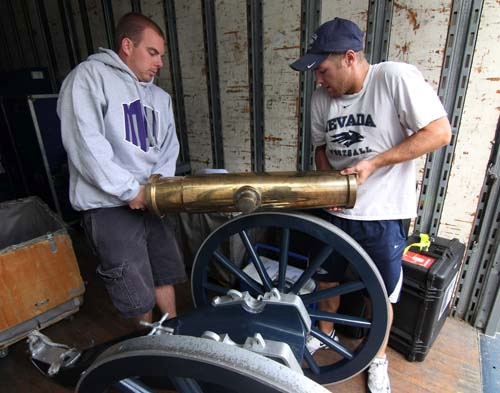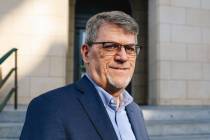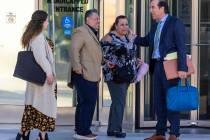Parts of real Fremont Cannon found near Nevada border
CARSON CITY - This afternoon at Sam Boyd Stadium, the UNLV Rebel and UNR Wolf Pack football teams will compete for the Fremont Cannon, a 545-pound replica of the howitzer that legendary explorer John C. Fremont abandoned in the Sierra Nevada snow on Jan. 29, 1844.
The real cannon, or so the story has gone for more than 160 years, remains lost. Explorers, history buffs and treasure hunters have searched in vain for the priceless artifact.
But an archaeologist with the U.S. Forest Service and a curator at the Nevada State Museum both say five parts of the Fremont Cannon have been discovered in a creek near the West Walker River, just inside the California state line, north of Bridgeport, Calif.
Fred Frampton, the archaeologist in Reno, was in the riverbed in 2006 when a group of authorized Bay Area volunteers, several of them professors, unearthed a metal tire rim. He has no doubt it once covered a wooden wheel from the actual cannon.
"I absolutely believe we have found parts of the Fremont Cannon," Frampton said. "As historical artifacts, they are priceless."
They want to keep secret its exact location, fearing treasure seekers will descend on the area. But the website www.longcamp.com gives pretty clear directions. Their fear of profit-minded nonprofessionals finding more parts, including the cannon's barrel, is perhaps the primary reason the find has received little public attention.
MUSEUM'S 'FREMONT CANNON'
Gene Hattori, curator of anthropology at the Nevada State Museum in Carson City, agrees with Frampton, although for the past 70 years his museum has had its own Fremont Cannon. Fremont himself agreed during a visit to Virginia City in the 1880s that the cannon housed in the firehouse there was the one he left behind, the curator said.
The museum's and the Fremont cannons are two of 13 manufactured in Boston in 1837. The cannons are made of the design that the French used in mountain warfare in Africa.
The museum cannon was found near Antelope Valley, Calif., in 1850. Over the years, it was moved to Virginia City and then Glenbrook on the Nevada side of Lake Tahoe. The cannon was fired during July 4 celebrations at Glenbrook. The Bliss family donated it to the museum in the 1940s.
Hattori noted that military historians also have determined the Bridgeport parts came from the real Fremont Cannon, while the authenticity of the museum's cannon has been challenged for generations. He also is convinced of their veracity because the parts were found where Fremont in his journals said it had been cached.
"Tonight we did not succeed in getting the Howitzer into camp," he wrote in the journal for Jan. 28, 1844. "This was the most laborious day we have yet passed through; the steep ascents and deep snow exhausting both men and animals."
The following day, standing at an 8,400-foot elevation, Fremont wrote "our little howitzer" was abandoned.
"They were struggling to get across the Sierra Nevada to Sacramento in the middle of winter," Hattori said. "They were in dire straits."
FREMONT TO BE HONORED
Hattori is preparing an exhibit to honor Fremont during Nevada's 150th anniversary celebration in 2014. Among the items on display at the state museum will be the parts found near Bridgeport and the museum's Fremont Cannon.
That cannon now is part of an exhibit celebrating Fremont in the Deschutes County Historical Museum in Bend, Ore. The museum has equipped the cannon, which previously rested on a large block of mahogany, with a carriage from an 1851 gun.
Fremont also visited Bend during the 1843-44 expedition. Residents there later discovered an iron pot and a cache of coins in the appropriately named Fremont National Forest that may have come his Fremont's party.
From Oregon, the Fremont expedition veered south into Mexican Nevada, looking for two fabled rivers that were supposed to run west from the Great Basin into the Pacific Ocean. What they found were not rivers, but a mountain barrier called the Sierra Nevada and winter storms that forced them to leave the cannon behind before they could head toward Sacramento, Calif.
BARREL SEARCH CONTINUES
The only cannon parts discovered so far are axle pieces, a part that connected the cannon to horses and three tire rims.
But the 225-pound barrel of the cannon remains lost. At least twice over the years, fishermen have reported to the Forest Service that they stepped on a huge object in the riverbed. The volunteers, using metal detectors and ground radar, have found nothing.
"They are still looking for it," Frampton said.
The "cannoneers," as Frampton calls the Fremont Howitzer Recovery Team led by James M. Allan, look for three or four weeks each summer.
Because the cannon parts were found on Forest Service land and are government property, Frampton supervised the dig when one of the team members' metal detectors found an object. The parts they found are on display at the Forest Service ranger office in Bridgeport.
Although the cannon barrel remains lost, Frampton maintains what has been discovered is of immense historical significance.
STILL OBSESSED
Folsom Lake, Calif., resident Ron Uzes said he has spent more than 500 days looking for the cannon barrel.
"I still believe I will find it," said Uzes, whose late father, Bud, led expeditions to find the Fremont Cannon. "The search has been an incredible life-changing experience and lots of fun."
Although he has not yet turned up the barrel, Uzes and his father did find the wagon wheel rims and axle parts of the cannon and turned them over to the Forest Service.
As a boy fishing in 1965, Uzes said he saw the head of a "fancy piece of brass pipe" in the creek where the other parts later were discovered. He tried to dig out the pipe but couldn't. Uzes remains convinced that pipe was the cannon barrel .
"I keep going back there," he said.
Uzes said he has been so obsessed with finding the barrel that he neglected the landscaping business he once owned in Nevada.
POPULAR AMERICAN
Nicknamed the "Pathfinder," Fremont (1813-90) was an explorer whose journal and maps became best-sellers used by gold-seeking 49ers heading for California and by the Mormons who settled Salt Lake City in 1847. He also was the first presidential candidate of the anti-slavery Republican Party, the first military governor of California and first U.S. senator from that state, a Civil War general and territorial governor of Arizona.
As a general in 1861, Fremont declared the slaves free in Missouri, two years before the Emancipation Proclamation. President Abraham Lincoln then relieved him of his command.
On the 1843-44 expedition when the cannon was lost, Fremont was a 31-year-old second lieutenant in the U.S. Army's Corps of Topographical Engineers.
Guided by Kit Carson, he and 30 men visited and named the Humboldt River, Pyramid Lake and the Carson River, all in Nevada. On Feb. 14, 1844, they became the first Americans of European ancestry to see Lake Tahoe. On the expedition's return journey, they camped in the lush meadows called Las Vegas.
In his May 3, 1844, journal entry, Fremont wrote: "After a day's journey of 18 miles, in a northeasterly direction, we encamped in the midst of another very large basin, at a camping ground called Las Vegas - a term which the Spaniards use to signify fertile or marshy plains, in contradistinction to llanos, which they apply to dry and sterile plains. Two narrow streams of clear water, 4 or 5 feet deep, gush suddenly with a quick current, from two singularly large springs; these, and other waters of the basin, pass out in a gap to the eastward. The taste of the water is good, but rather too warm to be agreeable; the temperature being 71 in the one and 73 in the other."
Two years later, Fremont and his U.S. Mounted Rifles would capture Santa Barbara and Los Angeles and take control of California from Mexico.
"He was the man," Frampton said.
Apparently so. Seven American cities are named after Fremont, with dozens of counties, mountains and streets, including Fremont Street in downtown Las Vegas.
PRICEY COLLEGE TROPHY
The Fremont Cannon is the heaviest and most expensive college trophy in America. Built by the Kennecott Copper Co. in 1969, the trophy cost $10,000 and was donated to the university system for the annual Battle of Nevada game.
Through 2005, the series stood at 15-15. Since then, the University of Nevada, Reno has won seven straight.
After beating UNR in 1999, UNLV fans tried to lift the cannon and broke it. Despite efforts to repair it, the cannon no longer is fired after each touchdown.
Frampton is not sure he wants the barrel of the Fremont Cannon ever found. In today's world, archaeologists prefer that Native American and early settler artifacts remain undisturbed.
Frampton has some advice for the person who finds the barrel:
"Leave it so it can be identified by professionals. This is the prize of Nevada history. Unless someone finds a carving knife of Joseph Walker or Peter Skene Ogden (earlier explorers), this is it."
Contact Capital Bureau Chief Ed Vogel at evogel@reviewjournal.com or 775-687-3901.





















